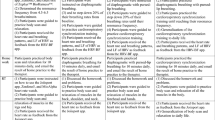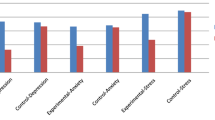Abstract
Clinical evidence for the long-term effectiveness of biofeedback related relaxation training is accumulating. The purpose of this report is to describe the population, self-regulation procedure, outcome criteria, and final outcome for patients who received Quieting Response (QR) training. Data from 340 patients who completed at least the first follow-up at 3 months is presented. Primary presenting symptoms were headaches, 72%; primary and secondary Raynaud's, 14%; hypertension, 4%; irritable colon, 4%; and miscellaneous, 6%. QR training integrated EMG and thermal feedback with deep breathing, progressive relaxation, and autogenic exercises presented on cassette tapes. Eight 1-hour weekly sessions were given, with emphasis on daily home exercises. Follow-up evaluations were at 3 months, 6 months, 1 year, and 2 years. Outcome was based on change in frequency, severity, and duration of symptoms; changes in medication; and secondary benefits. Quieting Response training was found to be most beneficial for patients with primary Raynaud's disease (18 of 23 patients, or 78% successful), classic migraines (9 of 13, or 69%), and common migraines (20 of 32, or 62%), followed by mixed headaches (79 of 131, or 60%), Raynaud's plus other symptoms (9 of 15, or 60%), and the irritable colon syndrome (7 of 13, or 54%). Less successful were patients with headaches plus other symptoms (16 of 37, or 43%), muscle contraction headaches (13 of 33, or 39%), secondary Raynaud's phenomenon (4 of 10, or 40%), and essential hypertension (5 of 15, or 33%). Speculations about the differing outcomes across symptom groups were made.
Similar content being viewed by others

References
Adler, C. S., & Adler, S. M. Biofeedback-psychotherapy for the treatment of headaches: A five-year follow-up.Headache 1976,16 189–191.
Blanchard, E. B., Miller, S. T., Abel, G. G., Haynes, M. R., & Wicker, R. Evaluation of biofeedback in the treatment of borderline essential hypertension.Journal of Applied Behavioral Analysis 1979,12 99–109.
Cohen, M. J., McArthur, D. L., & Rickles, W. H. Comparison of four biofeedback treatments for migraine headache: Physiological and headache variables.Psychosomatic Medicine 1980,42 463–479.
Davis, R. A., Wetzel, R. D., Kashiwagi, T., & McClure, J. N. Personality, depression, and headache type.Headache 1976,16 246–251.
Diamond, S., Diamond-Falk, J., & DeVeno, T.The value of biofeedback in the treatment of chronic headache: Five-year retrospective study. Paper presented at the meeting of the Biofeedback Society of America, Albuquerque, March (1978). (a)
Diamond, S., Diamond-Falk, J., & DeVeno, T. Biofeedback in the treatment of vascular headache.Biofeedback and Self-Regulation 1978,3(4), 385–408. (b)
Epstein, L. H., & Abel, G. G. Analysis of biofeedback training effects for tension headache patients.Behavior Therapy 1977,8 37–47.
Ford, M. R. Biofeedback treatment for headaches, Raynaud's disease, essential hypertension, and irritable bowel syndrome: A review of the long-term follow-up literature.Biofeedback and Self-Regulation 1982,7(4), 521–536.
Ford, M. R., Stroebel, C. F., Strong, P., & Szarek, B. L.Predictors of long-term successful outcome with Quieting Response training. Citation paper presented at the annual meeting of the Biofeedback Society of America, Chicago, March 1982.
Giles, S.Separate and combined effects of biofeedback training and brief individual psychotherapy in the treatment of gastrointestinal disorders. Paper presented at the meeting of the Biofeedback Society of America, Louisville, March 1981.
Haynes, S. N., Griffin, P., Mooney, D., & Parise, M. Electromyographic biofeedback and relaxation instructions in the treatment of muscle contraction headaches.Behavior Therapy 1975,6 672–678.
Jacobsen, A. M., Manschreck, T. C., & Silverberg, E. Behavioral treatment for Raynaud's disease: A comparative study with long-term follow-up.American Journal of Psychiatry 1979,136(6), 844–846.
Kudrow, L., & Sutkus, B. J. MMPI pattern specificity in primary headache disorders.Headache 1979,19 18–24.
Martin, P. R., & Mathews, A. M. Tension headaches: Psychophysiological investigation and treatment.Journal of Psychosomatic Research 1978,22 389–399.
Orne, M. T. On the social psychology of the psychological experiment: With particular reference to demand characteristics and their implications.American Psychologist 1962,17 776.
Patel, C. H. Biofeedback-aided relaxation and meditation in the management of hypertension.Biofeedback and Self-Regulation 1977,2(1), 1–41.
Rickles, W. H. Biofeedback in psychosomatic-narcissistic disorders. In H. P. Rome, F. J. Braceland, & D. L. Farnsworth (Eds.),Psychiatric Annals. (Vol. 11). New York: Insight Publishing, 1981. Pp. 23–41.
Russ, K. L., Hammer, R. L., & Adderton, M. Clinical follow-up: Treatment and outcome of functional headache patients treated with biofeedback.Journal of Clinical Psychology 1979,35(1), 148–153.
Sedlacek, K. Biofeedback for Raynaud's disease.Psychosomatics 1979,20(8), 535–541.
Silver, B. V., Blanchard, E. B., Williamson, D. A., Theobold, D. E., & Brown, D. A. Temperature biofeedback and relaxation training in the treatment of migraine headaches.Biofeedback and Self-Regulation 1979,4(4), 359–366.
Solbach, P., & Sargent, J. D. A follow-up evaluation of the Menninger pilot migraine study using thermal training.Headache 1977,17 198–202.
Stroebel, C. F.The psychophysiological diary: A computer scored daily record of moods, body changes, and life events (Rev. short form). Hartford: Institute of Living, 1973.
Stroebel, C. F.Quieting Response training. New York: BMA Audio Cassette Publication, 1978.
Stroebel, C. F.QR, the Quieting Reflex: A six-second technique for coping with stress anytime, anywhere. New York: Putnam's 1982. (a)
Stroebel, C. F.Quieting Reflex training for adults. New York: BMA Audio Casette Publications, 1982. (b)
Stroebel, C. F., & Glueck, B. C. Biofeedback treatment in medicine and psychiatry: An ultimate placebo? In Lee Birk (Ed.),Biofeedback: Behavioral medicine. New York: Grune and Stratton, 1973.
Author information
Authors and Affiliations
Additional information
Portions of this paper were presented at the XIIth Annual Meeting of the Biofeedback Society of America, Louisville, 1981. The authors gratefully acknowledge the contributions of Jonathan Boren and members of the Psychophysiology Clinic staff.
Rights and permissions
About this article
Cite this article
Ford, M.R., Stroebel, C.F., Strong, P. et al. Quieting response training: Long-term evaluation of a clinical biofeedback practice. Biofeedback and Self-Regulation 8, 265–278 (1983). https://doi.org/10.1007/BF00998856
Issue Date:
DOI: https://doi.org/10.1007/BF00998856



